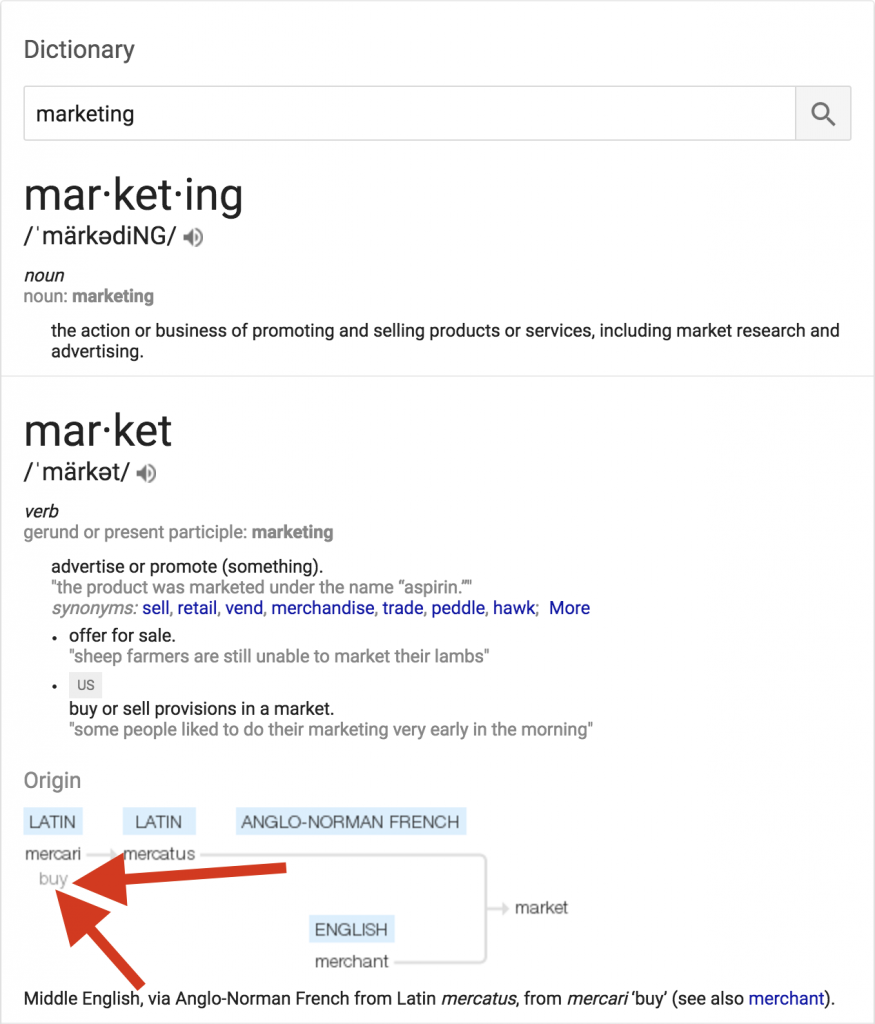So, how do we get sales and marketing aligned? At first glance, this might not seem like a very complicated question to answer. I mean, both departments have very similar goals, right? Now, ask me how we can align sales and legal? Ahhh, now that’s a question! Sales versus the sales prevention department – a heavyweight fight! But hold on a second, let’s not be so quick to dismiss the undercard of the evening – sales versus marketing. I’m kind of in a unique position when it comes to this question. You see, I’m a sales and negotiation subject matter expert who also owns a digital marketing agency. Therefore, I should be the most qualified person in the world to answer this question, but I have no idea what the hell to write about or even say.
Whenever I’m at a loss for words, I tend to go to a dictionary
I mean, where else would I go, right? So, I plugged ‘marketing’ into an online dictionary and what came up blew me away (well, “blew me away” might be a little excessive but it certainly piqued my interest.) This article that’s about to alter the direction of your life (excessive, sorry) is entirely based off a three-letter word found in an online dictionary definition. Can you guess what that word is from the screenshot below?
Do you need to sit down? Some water, perhaps? Tell me you’re not blown away right now? The word ‘marketing’ is a derivative of the Latin word ‘mercari,’ meaning ‘to buy.’ Marketing is, in fact, part of the buying family, not the selling family. All kidding aside, you’ve got to admit that looking at the subject of marketing as a buying process changes things up a little. For some, it might even change their entire approach to promoting and selling. Somewhere along the way marketing became a “promoting to sell” process when it’s intended to be an “attracting to buy “process. I wonder why that happened? Well, I’ll leave that golden nugget of a question for another article.
Can you get to your point, Tony? I don’t have all day.
Alright, calm down, I’m getting there. My point is that sales and marketing (formerly known as buying) are in fact complete opposites! They have opposite meanings. However, the good news is that opposites attract. They attract because they are dependent on each other for survival. Night does not exist without day. Cold without hot. Dry without wet. And sales without marketing. So, your company’s sales department is dependent upon the marketing department for survival and vice versa. Success is not possible without sales and marketing working in harmony because your sales department is only as good as your marketing department. As soon as one falls, they both fall. Discord between these two units will result in the suffocation and ultimate death of your organization. So, aligning your sales and marketing departments is an initiative that probably should get your full attention don’t you think? I mean the future of your job is dependent on it. So my guess is you’ll probably want your sales and marketing departments holding hands and singing kumbaya somewhere, right? How about trying these 4 strategies instead?
1. Understand and acknowledge each other’s role
Knowledge is power. Have a cross-training approach to your learning and development initiatives. Sales and marketing should be educating themselves about each other’s methodologies. Salespeople need to understand the latest trends in digital marketing and should have enough knowledge to carry on an intelligent conversation regarding storytelling, SEO, Social, PPC, etc. Marketing professionals need invest some time learning how to close a deal with a customer. Why not have your marketing personnel shadow sales as part of their onboarding process?
2. Study each other’s policy and guidelines
When dealing with procurement, I often ask to see their policy and guidelines. Once I get access, I put in the time and study it. Understanding your buyer’s policy and guidelines is a small price to pay for the success that it will reap. Do your sales and marketing divisions have their own separate internal policy and guidelines? If yes, how about making these documents accessible to both units and then testing them on it?
3. Articulate the values of key players
One of the first questions I ask a prospect is “who within your organization is making your life more difficult as a buyer?” You see, often a buyer wants to say “yes” to my product or service but they can’t because someone internally (a key player) is saying “no” to them. It’s the values of these key players that we truly need to understand because they are the roadblocks to our success. If I can understand these values more thoroughly, then the buyer and I can work as a team to convert that “no” into a “yes.” The same holds true when aligning marketing and sales. Salespeople must be able to articulate the values of the key marketing players and vice versa of course. Understanding these values will create a more collaborative and efficient sales and marketing unit. How about getting key players from sales and marketing expressing their values on video for easy sharing?
4. Help each other articulate the value they bring to the table
One of the most significant mistakes salespeople make when it comes to negotiating is bargaining (often discounting) before they’ve had a chance to sell their value. You see, if you can sell your value well at the beginning, then a lot of the negotiation issues will disappear later in the game. Sales and marketing people need to learn how to articulate their department’s value within their own company. What unique value does our marketing team bring to the company? What unique value does our sales team bring to the company? Try a role-playing exercise where sales and marketing personnel face-off against each other as a buyer and seller trying to sell their departments value proposition to one another. Not only is this exercise a lot of fun but it will make for an eye-opening group discussion right after.
Pipeliner CRM empowers companies to align sales and marketing. Get your free trial of Pipeliner CRM now.


Comments